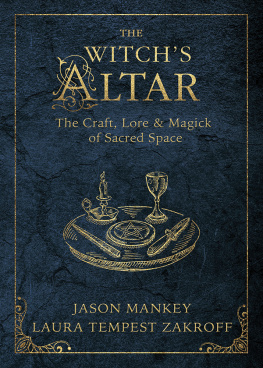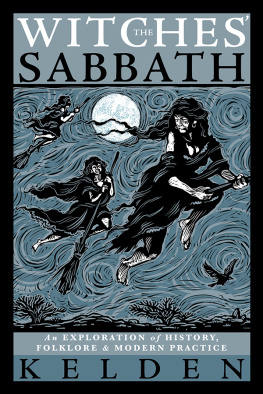Jason Mankey is a third-degree Gardnerian High Priest and helps run two Witchcraft covens in the San Francisco Bay Area with his wife, Ari. He is a popular speaker at Pagan and Witchcraft events across North America and Great Britain and has been recognized by his peers as an authority on the Horned God, Wiccan history, and occult influences in rock and roll. Jason writes online at Raise the Horns on Patheos Pagan and for the print magazine Witches & Pagans . You can follow him on Instagram and Twitter at @panmankey.

Llewellyn Publications
Woodbury, Minnesota
Copyright Information
The Horned God of the Witches 2021 by Jason Mankey.
All rights reserved. No part of this book may be used or reproduced in any matter whatsoever, including Internet usage, without written permission from Llewellyn Publications, except in the form of brief quotations embodied in critical articles and reviews.
As the purchaser of this e-book, you are granted the non-exclusive, non-transferable right to access and read the text of this e-book on screen. The text may not be otherwise reproduced, transmitted, downloaded, or recorded on any other storage device in any form or by any means.
Any unauthorized usage of the text without express written permission of the publisher is a violation of the authors copyright and is illegal and punishable by law.
First e-book edition 2021
E-book ISBN: 9780738763156
Cover design by Kevin R. Brown
Cover illustration by Laura Tempest Zakroff
For a list of interior art credits, please see Art Credits on
Llewellyn Publications is an imprint of Llewellyn Worldwide Ltd.
Library of Congress Cataloging-in-Publication Data
Names: Mankey, Jason, author.
Title: The horned god of the witches / by Jason Mankey.
Description: First edition. | Woodbury, Minnesota : Llewellyn Worldwide,
[2021] | Includes bibliographical references and index. | Summary: This
book is an in-depth look at the horned god as honored by todays
witchesProvided by publisher.
Identifiers: LCCN 2021005678 (print) | LCCN 2021005679 (ebook) | ISBN
9780738763088 (paperback) | ISBN 9780738763156 (ebook)
Subjects: LCSH: horned god. | Witchcraft. | Paganism.
Classification: LCC BL460 .M26 2021 (print) | LCC BL460 (ebook) | DDC
299/.942211dc23
LC record available at https://lccn.loc.gov/2021005678
LC ebook record available at https://lccn.loc.gov/2021005679
Llewellyn Publications does not participate in, endorse, or have any authority or responsibility concerning private business arrangements between our authors and the public.
Any Internet references contained in this work are current at publication time, but the publisher cannot guarantee that a specific reference will continue or be maintained. Please refer to the publishers website for links to current author websites.
Llewellyn Publications
Llewellyn Worldwide Ltd.
2143 Wooddale Drive
Woodbury, MN 55125
www.llewellyn.com
Manufactured in the United States of America
This book is dedicated to the memory of
Dwayne Arthur Sortor (19682020).
May your spirit run wild and free, my friend.
Contents
List of
: Finding the Horned God
: The Nature of Deity
: Myth and Ancient History
: Ritual to Meet the Horned God
: Antlers and Horns and Phalluses in the Ancient World
: Pan and the Other Horned Gods of Ancient Greece
: Igniting the Fire: A Pan Ritual For Two (or More)
: Cernunnos
: A Devotional Altar for Cernunnos
: The Green Man
: Herne the Hunter and Elen of the Ways
: The Rebirth of Pan
: The Devilish Horned God
: The Light of Lucifer Ritual
: The Horned God of Death
: John Barleycorn Ritual
: From Horned God to The God: The Horned One in Wicca
: The Witchfather: The Horned God in Traditional Witchcraft
: Ritual to Meet the Witchfather
: Some Final Thoughts
Figures
. Henri Breuils drawing of the Bison-Man at Trois-Frres
. The Sorcerer as drawn by Henri Breuil
. Pan
. A sacrifice for Pan
. Detail of a Grecian urn showing Dionysus flanked by satyrs and maenads
. Val Camonica rock drawing.
. Gundestrup cauldron
. Cernunnos panel on the Gundestrup cauldron
. The Reims stela
. The haunting image of the Green Man
. Herne the Hunter
. Elen of the Ways
. Lucifer
. A delightful Devil
. Robin Goodfellow
. Baphomet
. Krampus
. A shadowy-looking horned god, most likely resembling Cernunnos
. A depiction of the Horned God as he often appears in Traditional Witchcraft
Introduction
Finding the Horned God
Witchcraft practices are as varied as the snowflakes that fall in winter. There are Witches who work in covens and Witches who prefer to work independently. Witchcraft practices can be thousands of years old or exceedingly contemporary. There are Witches who have learned from teachers in group settings and Witches who are self-taught, trusting their intuition and perhaps learning from books and other resources.
Many Witches build their practices around the use of magick, with little use for any other trappings. I know some Witches whose rites are focused almost exclusively on the dead, both those who have died during their lifetimes and also the souls of long-ago ancestors from thousands of years ago. There are Witches whose practices revolve around nature, the turn of the seasons, and the power of the natural world. And then there are Witches like me who work primarily with deities, the most prominent one in my life being the figure most people call the Horned God.
The Horned God is a god, a title, and a way of describing particular deities found in the various strains of Modern Witchcraft. The Horned God can even be a Horned Goddess or perhaps have no gender at all, and hes most certainly straight, gay, transgender, and everything in between. I have to assume that as a force greater than mere mortals, deity is complex and most likely appears in different forms to different people.
Over the last eighty years, most authors of Witchcraft books have written about the Horned God as a single, genuinely ancient deity. According to this line of thinking, every horned or antlered deity is simply a reflection of the original one Horned God, and all horned and antlered deities share a multitude of traits and characteristics. This is a lovely piece of mythology, but its just not true. There was never just one horned god in pagan antiquity. Instead, there were a multitude of horned and antlered deities, all of them unique and different, with not all that much in common.
For the last hundred years, the Horned God has been pictured in a variety of ways, but his most important visual attribute is the set of horns or antlers atop his head. Yes, antlers and horns are very different things: horns are permanent structures, while antlers are shed and regrown annually. But pictures of the Horned God have included antlers for a very long time now, and Antlered God just doesnt roll off the tongue as easily.
Defining the Horned God
The term Horned God means different things to different people. For some, the Horned God is synonymous with nature and wild spaces. This is a Horned God whose journey through the Wheel of the Year mirrors the change of seasons, moving from youthful promise to young adulthood, middle age, and finally death. In my own practice, the Horned God is a figure who stands between two realms: this world and the lands of death.



















